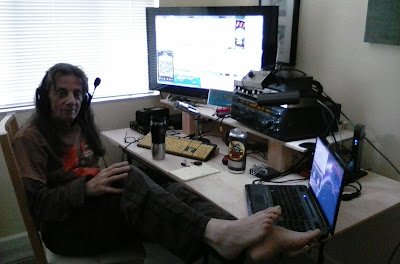I began my amateur radio "career" as a shortwave listener (SWL'er) before obtaining my first
FCC license; the more I listened, the more I learned about the HF spectrum (which has changed dramatically since the mid-1960's), and in particular the world of RTTY (and its early derivatives). Additionally, I learned how much more I needed to learn; especially when it comes to RTTY & the
other digital technologies.
Then in 1984, along came the AEA mba-Reader unit. Before committing to a full-featured
RTTY installation I purchased one of those Reader units (a WHOPPING $100 at the time). It was a thrill to see decoded messages scroll across the screen; unfortunately, often too
quick for making sense out of them. Sadly, that Reader quietly disappeared into the junk
box of some long-forgotten ham.
It was during my reconnection with N6GEO in 2009 that (with his patient elmering) I "discovered
by watching" how simple RTTY communication has become, IF you run everything on a suitably-powerful Windoze/MAC/Linux computer, with a reasonably-performing soundcard.
If RTTY is something you would like to explore, I recommend beginning JUST with receiving
RTTY; when you become confident with this ability, then tackle the interesting world of RTTY Xmit.
Learn what all the different software settings are for. Try different settings and notice the difference.
My simple approach to RTTY is running the MMTTY decoder (and sometimes FLDIGI)
software in conjunction with N1MM+ logging software (both FREE). Daytime listening
on 14.078 - 14.098 and nighttime listening on 7.080 - 7.100 for RTTY signals will give
you opportunities to learn the art of tuning RTTY signals.
Do you remember when you first learned to tune in SSB signals? For me, it was a bit tricky; now
I have no trouble quickly tuning in an Ssb voice. With practice, the same can be true for RTTY. Learning to tune signals by the sound of the tones is one way of doing it. Then again, in last weekend's CQ W.W. RTTY contest, the RX audio on my end of the remote connection failed. Using MMTTY's tuning display allowed me to run a frequency and even (with careful tuning)
Search & Pounce.
Another way to copy some more lengthy RTTY text is to listen every evening for W1AW's RTTY bulletins. Rather than publish W1AW's operating frequencies, I instead refer you to the latest information in the latest QST magazine and/or their website: ARRL.Org.
There are of course other digital modes such as PSK, AMTOR, JT-65, FT-4 & FT-8; and I know nothing about them - I can barely run RTTY. For me, running RTTY has become a LoT of fun.
Maybe one day I will consider the others. For now I'm simply gonna Do RTTY.
Maybe one day I will consider the others. For now I'm simply gonna Do RTTY.
If YOU Do RTTY like I Do RTTY.....
.....then we can RTTY Along.
C U then.




















































